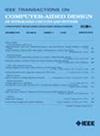基于均匀场效应效应的矩阵-向量乘法和关联搜索时域内存计算结构
IF 2.7
3区 计算机科学
Q2 COMPUTER SCIENCE, HARDWARE & ARCHITECTURE
IEEE Transactions on Computer-Aided Design of Integrated Circuits and Systems
Pub Date : 2024-11-06
DOI:10.1109/TCAD.2024.3492994
引用次数: 0
摘要
矩阵向量乘法(MVM)和基于内容的搜索是许多机器学习工作负载中的两个关键操作。本文提出了一种铁电场效应管(FeFET)时域内存计算(TD-CiM)阵列,该阵列可以在均匀结构中加速这两种操作。我们证明了1)MVM和基于内容的搜索所需的AND和异或/异或逻辑功能可以使用由串联的2个fet组成的单个内存计算(CiM)单元实现;2)基于逆变器链的TD-CiM阵列,结合TD-CiM的两相时域计算原理,可实现MVM和基于内容的搜索功能;3)通过将负载电容与基于逆变器链的TD-CiM阵列的每级相关联,实现信号延迟到数字的输出转换,保证了完全的数字兼容性;4)通过理论和实验的综合验证,所提出的2ffet单元和基于逆变链的TD-CiM阵列对ffet变化具有鲁棒性。我们展示了如何利用FeFET TD-CiM来加速超维计算(HDC),并通过动态和细粒度的资源分配来调整以处理不同的任务。HDC应用基准测试结果表明,与基于gpu的实现相比,所提出的基于fet的TD-CiM平均提供106 / 63倍的节能/加速。具有超过8500 TOPS/W的能源效率,所提出的基于fet的TD-CiM作为各种内存密集型应用的处理结构显示出巨大的潜力。本文章由计算机程序翻译,如有差异,请以英文原文为准。
A Homogeneous FeFET-Based Time-Domain Compute-in-Memory Fabric for Matrix-Vector Multiplication and Associative Search
Matrix-vector multiplication (MVM) and content-based search are two key operations in many machine learning workloads. This article proposes a ferroelectric FET (FeFET) time-domain compute-in-memory (TD-CiM) array that can accelerate both operations in a homogeneous fabric. We demonstrate that 1) the AND and xor/XNOR logic functions required by MVM and content-based search can be realized using a single compute-in-memory (CiM) cell composed of 2FeFETs connected in series; 2) an inverter chain-based TD-CiM array along with a two-phase time-domain computation principle of the TD-CiM can be employed to implement the MVM and content-based search functions; 3) a signal delay-to-digital output conversion can be implemented by associating a loading capacitor with each stage of the inverter chain-based TD-CiM array, ensuring the full digital compatibility; and 4) the proposed 2FeFET cell and inverter chain-based TD-CiM array are robust against FeFET variation according to our comprehensive theoretical and experimental validation. We show how the FeFET TD-CiM can be exploited to accelerate hyperdimensional computing (HDC) and adjusted to process different tasks through dynamic and fine-grained resource allocation. HDC application benchmarking results show that the proposed FeFET-based TD-CiM offers on average $106\times $ / $63\times $ energy reduction/speedup compared to GPU-based implementation. With more than 8500 TOPS/W energy-efficiency, the proposed FeFET-based TD-CiM exhibits huge potential as a processing fabric for various memory-intensive applications.
求助全文
通过发布文献求助,成功后即可免费获取论文全文。
去求助
来源期刊
CiteScore
5.60
自引率
13.80%
发文量
500
审稿时长
7 months
期刊介绍:
The purpose of this Transactions is to publish papers of interest to individuals in the area of computer-aided design of integrated circuits and systems composed of analog, digital, mixed-signal, optical, or microwave components. The aids include methods, models, algorithms, and man-machine interfaces for system-level, physical and logical design including: planning, synthesis, partitioning, modeling, simulation, layout, verification, testing, hardware-software co-design and documentation of integrated circuit and system designs of all complexities. Design tools and techniques for evaluating and designing integrated circuits and systems for metrics such as performance, power, reliability, testability, and security are a focus.

 求助内容:
求助内容: 应助结果提醒方式:
应助结果提醒方式:


